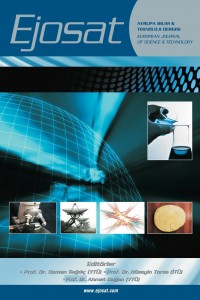Öz
Geleneksel gemi tasarım süreci tekne formunun modellenmesi ve sonrasında analiz edilmesi adımlarından oluşmaktadır. Bu iteratif süreç, arzu edilen performans değerleri elde edilene kadar formun genellikle deneme yanılma yoluyla değiştirilmesi şeklinde gerçekleşmektedir. Tasarım süresi tasarımcının bilgi birikimine ve tecrübesine bağlı olup ortaya çıkan sonuç genellikle optimum bir gemi formu olmaktan ziyade beklenen performans değerlerini sağlayabilen bir form olmaktadır.
Bu makalede, yeni nesil gemi tasarım yöntemlerinden biri olan Simülasyon Yönetimli Tasarım yaklaşımı kullanılarak gemi formu optimizasyonuna yönelik bir çalışma gerçekleştirilmiştir. Buna yönelik olarak CAESES adlı yazılım kullanılarak tam parametrik olarak modellenmiş olan gemi formu NSGA-II genetik algoritması kullanılarak direnç, denizcilik ve kargo hacmi amaç fonksiyonlarını optimize edecek şekilde modifiye edilmiş ve 160 farklı tekne formu türetilmiştir. Bu formlardan stabilite kriterlerine uymayanlar elenerek elverişli formlar ile Pareto-Optimal çözüm kümesi oluşturulmuştur. Çözüm kümesi içindeki formlar farklı önem derecelerine sahip senaryolara göre değerlendirilmiş ve optimum olarak belirlenen formlar başlangıç formu ile karşılaştırılmıştır.
Anahtar Kelimeler
Parametrik Modelleme Çok Amaçlı Optimizasyon Gemi Dizaynı Bilgisayar Destekli Tasarım
Kaynakça
- Deb, K., Pratap, A., Agarwal, S., & Meyarivan, T. (2002). A fast and elitist multiobjective genetic algorithm: NSGA-II. IEEE Transactions on Evolutionary Computation, 6(2), 182–197. https://doi.org/10.1109/4235.996017
- H., N., C., C., & C., M. F. (1977). Ship Lines Creation by Computer - Objectives, Methods and Results. Symposium on Computer-Aided Hull Surface Definition. Annapolis, MD, USA.
- Harries, S. (1998). Parametric Design and Hydrodynamic Optimization of Ship Hull Forms. Ph.D. Thesis, Technical University of Berlin.
- Harries, S., & Abt, C. (1999). Parametric Design and Optimization of Sailing Yachts. 14th Chesapeake Sailing Yacht Symposium. Annapolis, MD, USA.
- Huang, F., & Yang, C. (2016). Hull form optimization of a cargo ship for reduced drag. Journal of Hydrodynamics, 28(2), 173–183. https://doi.org/10.1016/S1001-6058(16)60619-4
- Kükner, A., & Sariöz, K. (1995). High speed hull form optimisation for seakeeping. Advances in Engineering Software, 22(3), 179–189. https://doi.org/10.1016/0965-9978(95)00016-P
- Lin, Y., He, J., & Li, K. (2018). Hull form design optimization of twin-skeg fishing vessel for minimum resistance based on surrogate model. Advances in Engineering Software, 123(April), 38–50. https://doi.org/10.1016/j.advengsoft.2018.05.010
- Lin, Y., Yang, Q., & Guan, G. (2019). Automatic design optimization of SWATH applying CFD and RSM model. Ocean Engineering, 172(November 2018), 146–154. https://doi.org/10.1016/j.oceaneng.2018.11.044
- Sener, B. (2012). Fırkateyn Tipi Tekne Serisi Geliştirilmesi Ve Hidrodinamik Form Optimizasyonu. Ph.D. Thesis Yildiz Technical University.
- Sener, B. (2016). Parametric Design of A Surface Combatant For Simulation-Driven Design And Hydrodynamic Optimization. International Journal of Mechanical and Production Engineering, (12), 125–129.
- Sener, B., & Yildirim, M. E. (2018). Bulbous Bow Optimization of KCS in Terms of Partially. International Journal of Mechanical and Production Engineering, (8), 47–51.
- Yu, J.-W., Lee, C.-M., Lee, I., & Choi, J.-E. (2017). Bow hull-form optimization in waves of a 66,000 DWT bulk carrier. International Journal of Naval Architecture and Ocean Engineering, 9(5), 499–508. https://doi.org/10.1016/j.ijnaoe.2017.01.006
Öz
Traditional ship design process consists of modeling and analyzing the ship form. This iterative process generally occurs in the way of changing the form by trial and error until the desired performance values are achieved. The design time depends on the knowledge and experience of the designer and the result is generally a form that can provide expected performance values rather than an optimum ship form.
In this article, a study on optimization of ship form was carried out by using the Simulation Driven Design approach, which is one of the new generation ship design methods. For this purpose, a fully-parametric ship hull form modeled using the software named CAESES was modified to optimize the hull form according to resistance, seakeeping and cargo volume objective functions using the NSGA-II genetic algorithm and 160 alternative hull forms were derived. Pareto-Optimal solution set was created with suitable forms by eliminating the hull forms that not provide the stability criteria. The hull forms in the solution set were evaluated according to scenarios with different severity levels and the optimum hull forms were compared with the initial hull form.
Anahtar Kelimeler
Parametric Modeling Multi-Objective Optimization Ship Design Computer Aided Design
Kaynakça
- Deb, K., Pratap, A., Agarwal, S., & Meyarivan, T. (2002). A fast and elitist multiobjective genetic algorithm: NSGA-II. IEEE Transactions on Evolutionary Computation, 6(2), 182–197. https://doi.org/10.1109/4235.996017
- H., N., C., C., & C., M. F. (1977). Ship Lines Creation by Computer - Objectives, Methods and Results. Symposium on Computer-Aided Hull Surface Definition. Annapolis, MD, USA.
- Harries, S. (1998). Parametric Design and Hydrodynamic Optimization of Ship Hull Forms. Ph.D. Thesis, Technical University of Berlin.
- Harries, S., & Abt, C. (1999). Parametric Design and Optimization of Sailing Yachts. 14th Chesapeake Sailing Yacht Symposium. Annapolis, MD, USA.
- Huang, F., & Yang, C. (2016). Hull form optimization of a cargo ship for reduced drag. Journal of Hydrodynamics, 28(2), 173–183. https://doi.org/10.1016/S1001-6058(16)60619-4
- Kükner, A., & Sariöz, K. (1995). High speed hull form optimisation for seakeeping. Advances in Engineering Software, 22(3), 179–189. https://doi.org/10.1016/0965-9978(95)00016-P
- Lin, Y., He, J., & Li, K. (2018). Hull form design optimization of twin-skeg fishing vessel for minimum resistance based on surrogate model. Advances in Engineering Software, 123(April), 38–50. https://doi.org/10.1016/j.advengsoft.2018.05.010
- Lin, Y., Yang, Q., & Guan, G. (2019). Automatic design optimization of SWATH applying CFD and RSM model. Ocean Engineering, 172(November 2018), 146–154. https://doi.org/10.1016/j.oceaneng.2018.11.044
- Sener, B. (2012). Fırkateyn Tipi Tekne Serisi Geliştirilmesi Ve Hidrodinamik Form Optimizasyonu. Ph.D. Thesis Yildiz Technical University.
- Sener, B. (2016). Parametric Design of A Surface Combatant For Simulation-Driven Design And Hydrodynamic Optimization. International Journal of Mechanical and Production Engineering, (12), 125–129.
- Sener, B., & Yildirim, M. E. (2018). Bulbous Bow Optimization of KCS in Terms of Partially. International Journal of Mechanical and Production Engineering, (8), 47–51.
- Yu, J.-W., Lee, C.-M., Lee, I., & Choi, J.-E. (2017). Bow hull-form optimization in waves of a 66,000 DWT bulk carrier. International Journal of Naval Architecture and Ocean Engineering, 9(5), 499–508. https://doi.org/10.1016/j.ijnaoe.2017.01.006
Ayrıntılar
| Birincil Dil | Türkçe |
|---|---|
| Konular | Mühendislik |
| Bölüm | Makaleler |
| Yazarlar | |
| Yayımlanma Tarihi | 1 Nisan 2020 |
| Yayımlandığı Sayı | Yıl 2020 Ejosat Özel Sayı 2020 (ARACONF) |


